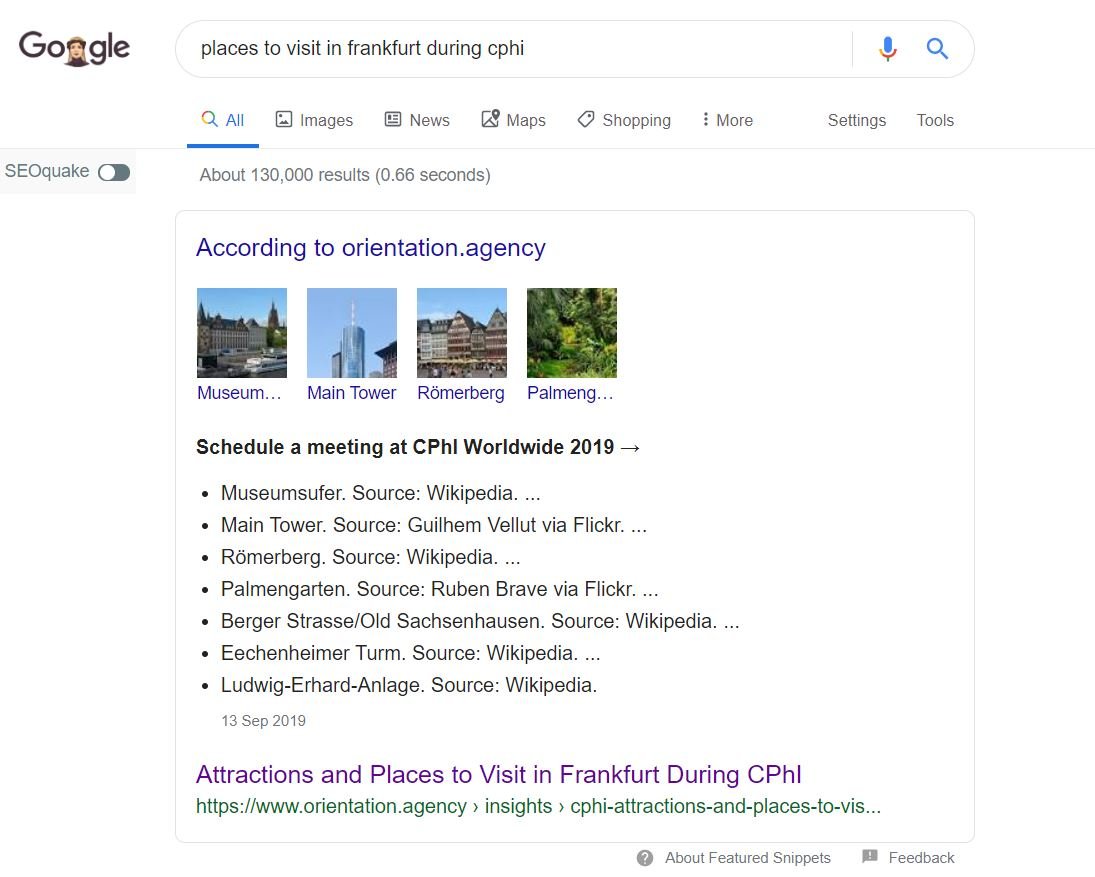Pharma SEO Strategies For More Visibility
SEO for pharma marketers… and why you need to be on top of your search content game
Let’s address the elephant in the room for pharma marketing: SEO.
Search engine optimisation (SEO) is the process of optimising websites and its content to bring more opportunities to the website via Google and other search engines.
The associated benefits include generating more traffic, converting more visitors by attracting more relevant traffic, boosting awareness of the brand, service expertise and products and well as drive sales offline and online.
Subscribe for marketing insights via email
But the benefits occur only if web pages appear on the first page of Google’s search results. Reaching these positions, however, is not often considered a priority for pharma and life science marketers. This, to me, seems rather strange.
To think that science professionals do not use the internet to search for information strikes me as naive. Of course, scientists and those working in science organisations will use journals and other traditional research-based channels for information. These are trusted channels which science professionals have always used. But they will also, due to their curious nature, explore other channels for accessing information and search engines like Google will often top of that list.
Pharma marketing professionals are quickly realising that a whole world of opportunity exists away from traditional methods, with SEO (and a wider content marketing strategy) being one of the key avenues in this sector.
Could you attract more organic visitors to your content via SEO in 2020?
Before you do anything, look at the keywords you would like to target (what you think your target audience might use to find your web pages), what your website is actually targetting as well as what keywords your website is ranking for before we jump into some pharma SEO tips and strategies…
10 AREAS TO FOCUS YOUR PHARMA SEO
SEO is considered a difficult and complex task. For the most part, this is true. But what is also true is that pharma marketers can look to gradually work on their SEO efforts to increase the number of organic visitors to the website over time.
And SEO takes time. Just be aware that results will also take time which means you will have to continually work on SEO tasks, but know that the results will materialise.
Consider the 10 pharma SEO tips, strategies and areas to focus your efforts below to start improving your rankings on Google and other search engines to generate more qualified website traffic.
1. MOBILE-FIRST INDEXING
Mobile-first indexing took priority in 2018 and since then it has been a focus for every website looking to attract more organic visitors. Since 9/10 of us use smartphones, it’s an absolute must to ensure mobile usability and consider adopting AMP (accelerated mobile pages) which strips down other content to show content immediately upon the page load. Being rich with high-quality content, AMP version compatibility is also must for any website to survive in this competitive era. If you do anything for 2020, ensure that your website is mobile-friendly.
(1) Google’s free mobile-friendly test will review your website within a few seconds and will provide accurate tips - often technical that will require a developer - for your own website. There is a good chance that you are already optimising for mobile, but if not, a (2) look at your website and it’s user experience design - a redesign might be calling. Simple website designs that load quickly are always good in Google’s eyes and will almost always translate well on mobile.
2. PREPARE FOR VOICE (FOR NATURAL LANGUAGE PROCESSING)
Voice search is a speech recognition technology that provides customers with the ability to search with their voice. The technology involved is still in an immature state, and even though we use might Google’s Voice Assistant, Apple’s Siri or Amazon’s Alexa and we see more and more product offerings for the technology, we still might not be totally convinced. But that doesn’t mean in 5-10 years time (or even sooner) things will not change as the technology advances further. This is why it’s sensible to prepare this SEO consideration within pharma, especially since mobile is so dominant. Other sectors understand this and are making the necessary preparations.
To prepare for voice, consider natural language processing when creating content. (1) Write in a conversational tone in the way that people (especially your customers) speak and (2) include long-tail keywords and questions within the content itself. Know your keywords and then frame your content in this manner so you are providing information for real pharma SEO queries.
3. INCLUDE VIDEO ON PAGES
Just like mobile, which has been featured on lists such as this one for some time, online videos are still worthy of their status as a major SEO consideration to boost rankings. And every video you create - once optimised for SEO with the appropriate descriptions, transcripts, tags and titles - has the ability to generate its own traffic to your website, not to mention boost the overall rankings of that website in the process. If you do not have videos, link to or embed other videos from Youtube for relevancy. Did you also know that video featured snippets are going to feature more in the featured snippets sections on SERPs?
4. RICH CONTENT FOR THAT FEATURED SNIPPET
The ultimate aim for each piece of pharma SEO content is Google’s featured snippet - the content box which appears before the usual list of pages on a SERP. Google gives sees this as the most appropriate answer for the search query out of all of its indexed pages and will provide the content of that page in a summary (often bulleted) text. As you can imagine, being top of the page brings with it maximum visibility. The screenshot below shows an example of one of our own pages answering a specific question or longtail search query - a blog post featuring attractions and places to visit in Frankfurt during CPhI - which is currently ranked in the featured snippet position.
Orientation.agency featured snippet example.
Backlinko suggests that 40% of Google’s Home (a voice-enabled device) results comes from the featured snippet, so it’s something to consider when writing and optimising content. The key here (apart from writing informative content) is to ensure you’re answering your audience’s potential questions. (1) Focus each individual piece of content on long-tail keywords, (2) write with clear numbered, bulleted or headlined text and of course (3) write with natural language processing in mind.
5. ENSURE YOUR CONTENT IS USEFUL
Since the dawn of digital, SEO practitioners have been suggesting that the most important SEO factor is to ensure that content is of high quality and is highly useful for readers. I would have to agree, certainly in pharma. Each piece of content requires research to ensure that content is accurate and up-to-date, as well as helpful for readers. Writing your content isn’t a task to be completed quickly over your lunch break; it requires long periods of time, even days, to ensure it hits the sweet spot and performs for your website long term. This post, for example, has taken two full days to write and weeks of initial experimentation.
Content means more than just a blog post. Pharma content covers video, app notes, podcasts, live chat, case studies, whitepapers and infographics, amongst anything else that appears on your website or on the internet so you have options to reach your science audience. Make certain that the content grabs users within the first few seconds, and then ensure that the main body provides an abundance of useful information presented in an engaging format that can open up further pageviews or even discussions with your organisation. We have previously compiled a list of science content marketing challenges (with solutions) which you may find useful when looking to create more content.
6. TARGET SEARCH INTENT
Each search on Google has its own level of intent. Perhaps a particular search consists of casually looking something up or to compare that something with something else or even to buy that something. Whatever that something is, there needs to be a page appearing on Google for that type of search intent. Pharma is a crowded space, but if you’re appearing on the first page for each of these searches for your product or service, you are likely to generate more organic visitors. Visitors who are looking for exactly what you provide.
This is by no means an easy task. But once you know your audience (and have created your own buyer personas) you can segregate your buyers into three buyer journey stages: awareness, consideration and decision. Each stage takes into account the user’s frame of mind when searching for something, which you can tailor your content and keywords towards. We have previously written an article on Types of Science Content Per Buyers Journey Stage which provides guidance.
7. BACKLINKS ARE (STILL) HUGELY IMPORTANT
I’d say after content, this is the most important SEO element. Backlinks to websites can generate traffic, build credibility and rank your website higher on search engines, as these links hint at Google about your website’s importance. When writing, sharing and distributing content, always keep one eye on the number of backlinks that could be generated from that piece of content. (1) Assess your distribution strategy and (2) identify the gaps where your content could fill, (3) always looking for that opportunity to generate a link back to one of your web pages.
Total impressions for Orientation.agency (Sept-Dec)
The Orientation Marketing website is a small site featuring a limited amount of service-based pages, as well as a blog that’s updated once a week. In August through October, we embarked on a small-scale (when we had free time away from client work!) backlink building campaign with the aim of increasing the number of links pointing back to various pages of the website. Alongside, we also improved upon the internal linking throughout the blog, resulting in a 404% year-on-year growth for organic visits from the period of November, demonstrated in the leap in impressions for the last three months as the domain authority increased.
Although this was achieved in the B2B pharma marketing space, pharma organisations in all verticals, both B2B and B2C, compete within the same arena with the same set of factors with a buyer persona who is looking for information to complete tasks on search engines. Highly quality backlinks from high authority domains do the world of good for your organic visibility.
8. CHECK YOUR ON-PAGE SEO
We will see in point nine that Google has evolved and ranks websites on more factors other than on-page factors. But that doesn’t mean that pharma marketers, or any marketer for that matter, should discount on-page SEO elements. Ensure that the page is appropriately set up. If your page isn’t optimised appropriately, then Google may not know exactly what your page entails.
(1) Include keywords in your URL but (2) keep that URL relatively short. (3) Front-load your keywords into all titles, descriptions and in the body so that Google can clearly see the focus of the page and (4) ensure the chosen keywords are appropriately tagged within these titles with the H1, H2, H3 and H4 tags where appropriate. (5) Your page really needs to have (on average) at least 800 words to have the depth Google would consider as informative. You can use an SEO checker to analyse and track how to improve your site.
One of the most comprehensive SEO checklists I have come across for this on-page exercise, featuring much of the tips in this section, is by Backlinko and can be found here.
9. FOCUS ON BUILDING YOUR EXPERTISE, AUTHORITY AND TRUST (EAT)
As Google has become older and wiser, it now looks to rank web pages based on the overall authority of the domain, rather than just how informative the actual web page is. This is to crack down on those trying to manipulate some of the more historic SEO signals such as on-page SEO (even though it shouldn’t be ignored). So to counter this for pharma SEO, (1) look to build your brand with accurate and detailed content, on your website and on other websites. (2) Build on this further with other thought leadership style content, such as guest contributions and speaking opportunities. Points 5 and 7 will contribute to this.
Organisations in the healthcare space, for example, have reportedly struggled here as information may be inaccurate and Google is looking for sites to prove their overall EAT. So, rather than think short-term always think long-term with your SEO efforts - this is a prerequisite in the pharma sectors. Your aim is to tell Google in as many ways as possible that your organisation (and website) is an expert, is authoritative and is trustworthy and you can do this with thought leadership and content/inbound marketing outlook that points back to your primary domain.
10. DON’T FORGET VISUAL
Noticed the variety of images within blog posts over the past year or so? Noticed the infographic that summarises all of the key pharma SEO tips at the top of this post? You’re making life easier for your potential audience by providing an image that summarises content which the audience can quickly digest, in turn, telling Google that your content is more relevant than a competing post without an image.
Some key aspects with regards to visual search: (1) Include a descriptive alt text within the image, (2) optimise the image size, titles and file names and (3) see high-quality images that, if possible, are unique. Internet users are becoming more and more visual users; adopt this trend within your content campaigns - (4) even submit those images within the sitemap of your website (popular CMS providers will do this by default) to ensure your images get impressions even if your web page isn’t visited.
YOUR PHARMA SEO STRATEGY FOR 2020 AND BEYOND
Keep up to date with Google’s updates at all times. The pool of potential prospects that can find you via this channel is far greater than social and email, for example.
This post provides an overview of just some of the tips which your pharma organisation can adopt to improve its rankings. There are many more ways for improving your search visibility - I suggest visiting the blogs of Backlinko, Moz or SEMrush for more SEO guides. But if you want to start right away with your pharma SEO campaign, start with building content and backlinks. Or hire an SEO company.
Before embarking on your SEO campaign, or any marketing campaign for that matter, ensure your campaign has the best chance of succeeding by following a set of pre-determined strategic steps via our pharma marketing plan template.





